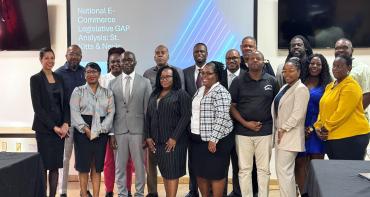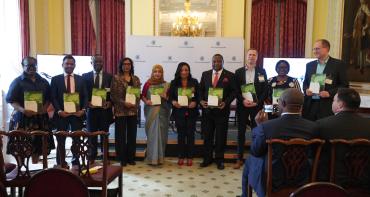Executive Summary
Fisheries are inherently complex systems fraught with challenges. In addition, fishing is one of the most dangerous occupations globally and in some regions suffers from human rights abuses. Aside from these challenges, fisheries provide livelihoods and a primary source of protein to many of the world’s coastal communities, particularly those in developing nations. It is, therefore, imperative that the challenges faced in fisheries are well understood and solutions are found to overcome them.
Technology, when combined with good governance, has a role to play in closing current knowledge gaps and in finding solutions to fishery challenges to help ensure sustainable, safe and equitable fisheries. More specifically, digital innovations and digitalisation along with data infrastructure, business development and investment, and appropriate enabling environments hold promise in improving the future sustainability of fisheries.
This report reviews the current state of the art of digital innovation in each the five Commonwealth regions by taking a structured literature review approach supplemented by interviews with key informant experts. For each region, the report summarises digitalisation by dividing the concept into three distinct pillars:
- Pillar 1: Digital innovations
- Pillar 2: Data infrastructure
- Pillar 3: Business development and investment
These three pillars are supported by a fourth element: the ‘base’ of enabling environments for digitalisation.
This study ends with a clear set of recommendations for improved digitalisation in fisheries in the Commonwealth along with some pioneering technologies that appear promising in certain regional contexts.
Broadly, the current state and future potential of digitalisation in fisheries are largely determined by the scale of the fisheries in discussion. Across all the Commonwealth regions, small-scale fisheries that involve low-tech fishing vessels and gear, with small (often single person) crews, suffer from a lack of self-driven capital injection or external investment to make use of new technologies. These fisheries are, therefore, ubiquitously less able than large-scale vessels to fund their own digitalisation and therefore generally rely on external revenue whether it be philanthropic funding or government-driven initiatives. This situation is more pronounced in developing world economies, particularly in Africa and the areas of Asia. Considering approximately 90 per cent of the world’s fisheries are classed as small scale, a huge opportunity therefore exists for the role of digitalisation in the small-scale sector.
The availability of the quality catch data is the most obvious place to start to make improvements because without it, sustainable management of the resources upon which fishers rely will not be possible. Robust catch and subsequent supply chain data is, however, often marred by illegal, unreported and unregulated (IUU) fishing, which is a worldwide phenomenon, with hotspot in areas with poor monitoring control and surveillance activities (such as West Africa, the High Seas and SE Asia).
Without sufficient monitoring and subsequent robust catch data collection, many digital solutions will lack the necessary data to move beyond descriptive analytics towards predictive and prescriptive analyses. Catch documentation and real-time landings recordings are hindered in many regions by poor coastal network connectivity which is why concurrent investment must also be made in infrastructure to bring Internet connectivity to remote regions.
With this connectivity will also come additional opportunities for digitalisation such as sea safety, and marketing and personal finance applications that will allow fishers to guarantee sale of catches before landing and investigate optimal markets in near-real time. This increases business security whilst also providing a means by which supply chains can know what to expect from the catch sector daily. For areas that have already benefitted from the use of mobile money and personal finance applications, an equally important offshoot is the first official record of personal identity for many which has broad social connotations, including gender equality, particularly in remote regions.
More advanced technologies such as artificial intelligence and block chain are still in their infancy both in large- and small-scale sectors. Although momentum is building with some select success stories, widespread adoption of such technologies will continue to be hindered by a lack of infrastructure that allows sufficient connectivity to make cloud-based data upload and download possible. Government regulation and the correct collaboration with technology industries will be crucial to ensure that the foundations of connectivity and the technologies themselves are available to the sector at viable costs.
Despite the promise of digitalisation, in practice, a common theme appears to be large initial capital injections to begin projects, but without proper business planning. There are few examples of self-perpetuating funding models, resulting in many projects that are built, used for short periods, and run out of funding to maintain hardware and services, irrespective of how popular they are within the sector.
The COVID-19 pandemic has highlighted many weaknesses within fisheries systems and associated supply chains globally, and some have hoped that it will act as a catalyst for change, particularly within rural economies. Whether the positive changes that have happened to date (see COVID section in Chapter 1) will persist remains to be seen.
Key recommendations include
- Pillar 1: Digital innovations are significantly lacking in many small-scale fishery contexts. It is, therefore, important that awareness is created, and training is given to both user groups (fishery stakeholders) and governments and business people to promote digitalisation to improve the ease as well as sustainability of their operations. The production of country-specific state-of-the-art reports can highlight the sorts of opportunities and innovations that are suitable in that country’s context.
- Pillar 2: Data infrastructure improvements can be made through better policy formation that facilitates data sharing, particularly among government, fishers and industry. This, however, will ultimately rely on appropriate capacity being built in terms of personnel, data storage and connectivity systems. Private–public partnerships should be explored.
- Pillar 3: Business development and investment within the fisheries sector can be strengthened through the formation of cooperative-type structures that can give fishers a stronger voice but also pool resources for the benefit of the whole rather than the individual. Improved incentivisation schemes are also needed in contexts where trust among government, technology industries and the fisheries sector remains poor. This will help push data collection initiatives whilst also promoting the use of new technologies and solutions as they emerge. Where incentivisation is not appropriate or possible, engaging the fisheries sector through partnership building, joint projects or community consultations, thus moving away from top-down management, would be highly beneficial.
- The ‘base’: Enabling environments for digitalisation need improvement through the development of legislation that can help promote funding programmes and encourage governments to reduce connectivity costs for digitalisation initiatives. National surveys of education and technology adoption will also help give high-resolution context-specific information that can be used to develop targeted digital literacy campaigns. Ensuring fishers understand the benefits of digital solutions and services is imperative to success, for both individual fishers and the wider sector. Thus, appropriate training and education is imperative to digitalisation efforts within the sector.
Finally, knowledge sharing is a key, and efforts are needed to promote successful digitalisation case studies and to highlight the benefits that digitalisation can bring to fishery stakeholders in the Commonwealth.
There is a considerable potential for fisheries digitalisation across the Commonwealth, but the contexts are diverse. This report acts as a high-level pass over a complex subject that we believe requires at least per-country (if not per areas within country) research and further investment.
Contact us
Acknowledgements
The information contained in this book is solely for the use of the Commonwealth Secretariat for the purpose for which it has been prepared. MarFishEco Fisheries Consultants Ltd undertakes no duty to or accepts any responsibility to any third party who may rely upon this document.
All rights reserved. No section or element of this document may be removed from this document, reproduced, electronically stored, or transmitted in any form without written permission of MarFishEco Fisheries Consultants Ltd or the Commonwealth Secretariat.
Prepared for the Commonwealth Secretariat by MarFishEco Fisheries Consultants Ltd
Authored by: Morgan Lord (Fisheries Ecologist and Stakeholder Lead) and Andrew F Johnson (CEO) of MarFishEco Fisheries Consultants Ltd
We would like to thank all the expert key informants that provided valuable insight that was essential in understanding the nuances in differences between the regions. Thanks also go to those who helped facilitate those conversations and directed us towards materials. We are also grateful to the Commonwealth Secretariat, in particular Dr Benjamin Kwasi Addom for his help formulating this report and inviting us to use the framework laid out by the Secretariat to describe the different pillars of digitalisation.
About MarFishEco Fisheries Consultants Ltd:
MarFishEco Ltd is a network of senior fishery professionals with experience in over 25 countries, helping to formulate and implement viable and practicable sustainability solutions across fishery sectors. Headquartered in Edinburgh, Scotland, with offices in Portland, Oregon and the USA, MFE is a trusted source of objective advice and support for the future of sustainable and profitable fisheries.



